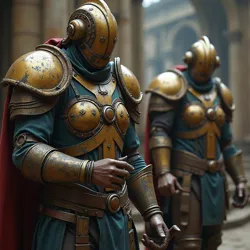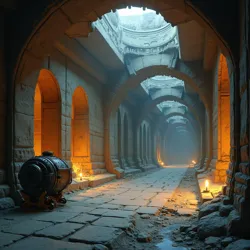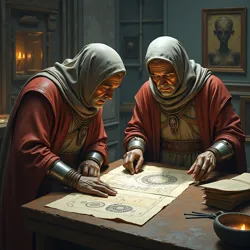Gear Guardians

Members of the Elysian Machine-smiths focused on preserving and interpreting ancient technology from past eras.
Elysian Machine-smiths
Ancient technology preservation
Historical tech analysis, artifact safeguarding
War for Unity aftermath
Idris Vorsen
Custodians of ancient knowledge
Salvatros
Hebhastun and other districts
| Machine-smith Sect | Primary Focus | Key Expertise | Role in Theocracy/Technarchate |
|---|---|---|---|
| Technomancers | Mental Interface with Technology | Psionic-Tech Synchronization, Data Manipulation | Optimizing current systems, enhancing user interaction |
| Gear Guardians | Ancient Technology Preservation & Interpretation | Historical Tech Analysis, Artifact Safeguarding | Custodians of ancient knowledge, maintaining legacy systems |
| Cog Magi | Cybernetic Augmentation | Bio-Integration, Prosthetics, Mechanical Enhancement | Enhancing physical forms, medical technology, |
The Gear Guardians are one of the four principal sects within the greater body of Elysian Machine-smiths of the Technarchate of Elysia. Distinguished by their emphasis on historical preservation, technical interpretation, and the safeguarding of ancient technologies, the Gear Guardians represent the most learned, hermetic, and often elder members of the Machine-smiths. Their primary function is the discovery, understanding, and secure storage of technological artifacts and knowledge inherited from predecessor civilizations across the galaxy of Uran and within the domains of the Omnium Theocracy.
Unlike the Technomancers who specialize in mental interfacing with current technology, the Cog Magi focused on cybernetic augmentation, or the Circuit Theurgists dedicated to the creation of Noetic Sapients, the Gear Guardians are primarily concerned with the legacies of the past. They delve into ruins, decipher forgotten schematics, and maintain ancient apparatuses whose operational principles may be only dimly understood by contemporary Elysian engineering. Their role became particularly critical following the galaxy-conquering War for Unity and the subsequent Age of Light under Grand Technarch Idris Vorsen, as widespread conflict and exploration led to the rediscovery of powerful, potentially dangerous technologies from collapsed empires, including remnants of the ancient Lort’zyn civilization.
The sect's foundation is intrinsically linked to the aftermath of the War for Unity. Following a brutal engagement on the Planet Luth, where rediscovered handheld nuclear firearms of immense power were captured, the need for a dedicated order to handle such volatile artifacts became apparent. Idris Vorsen, himself driven by an interest in lost knowledge and the potential of ancient mechanisms like the Oscillating grids he discovered, formally established the Gear Guardians. Their mandate was clear: to prevent the misuse of potent, easily misapplicable apparatuses by securing them and interpreting their underlying principles for the benefit of the Technarchate and, later, the theocracy. This historical mandate continues to shape their cautious and often secretive approach to technological discovery.
History and Formation
The formal establishment of the Gear Guardians as a distinct sect of Elysian Machine-smiths traces its origins to the later stages of the War for Unity, a period of intense conflict and technological rediscovery that unified the galaxy of Uran under the rule of Grand Technarch Idris Vorsen. Prior to this, Elysians with a penchant for historical technology existed, but their efforts were largely disparate, confined to academic circles or independent archaeological endeavors. The rapid expansion and military campaigns of the nascent Technarchate brought them into contact with countless worlds bearing the technological debris of ages past, particularly those influenced by the ancient, now-fallen Yronum empire.
 Gear Guardians carefully extracting a potentially dangerous technological artifact from a ruined site during an expedition.
Gear Guardians carefully extracting a potentially dangerous technological artifact from a ruined site during an expedition.A pivotal moment occurred during the assault on Luth, a world scarred by millennia of prior conflicts. Elysian forces uncovered caches of potent, pre-Technarchate weaponry, including handheld devices capable of unleashing devastating nuclear energies. The raw power and inherent instability of these artifacts, combined with the difficulty in understanding their operational mechanisms, highlighted a critical gap in the Technarchate's capabilities. While other Machine-smiths excelled in contemporary design and application, none possessed the specialized knowledge or cautious discipline required to safely handle and interpret technologies operating on principles long forgotten or fundamentally different from standard Elysian cold fusion and psio-conductive Hrysium metallurgy.
Idris Vorsen, whose own rise to power was catalyzed by the discovery of lost knowledge and ancient Oscillating grids, recognized the strategic necessity of mastering these legacies. He envisioned a dedicated order that would act as technological historians, archaeologists, and custodians. Drawing upon the most experienced and intellectually rigorous individuals among the existing Machine-smiths and scholars interested in ancient lore, he formally decreed the formation of the Gear Guardians. Their initial ranks were filled by those who demonstrated not only technical aptitude but also patience, discretion, and a deep respect for the power of the past.
Early Mandates and Challenges
The initial mandate of the Gear Guardians was twofold: first, to systematically locate, secure, and catalog all dangerous or poorly understood ancient technologies encountered by Technarchate forces and explorers; and second, to decipher the principles behind these technologies. This often involved perilous expeditions to war-torn worlds or long-abandoned installations. Early Gear Guardians faced significant risks, not only from the unstable nature of the artifacts themselves but also from other factions who might seek to exploit such power.
Their work was slow and painstaking. Ancient technological artifacts were rarely accompanied by legible schematics or operating manuals. Interpretation often required a combination of reverse engineering, comparative analysis with other discovered relics, and sometimes even intuitive leaps guided by deep understanding of fundamental physical laws and energy manipulation. The hermetic nature of the sect developed partly out of necessity; the study of potentially volatile technology required secure, isolated facilities, and the sheer volume and complexity of the work demanded intense focus, drawing members away from more public roles within Elysian society.
The Gear Guardians quickly established themselves as indispensable. Their expertise allowed the Technarchate to integrate certain ancient principles into its own technology, improving efficiency and developing new applications. However, they also advocated for the strict control and, in many cases, permanent sequestration of the most dangerous relics, arguing that their destructive potential outweighed any potential benefit. This cautious stance sometimes put them at odds with more ambitious elements within the Technarchate who favored rapid technological advancement at any cost.
Integration into the Omnium Theocracy
With the creation of the Pantocrator’s landmass by Uzhyr and the subsequent migration of Elysians to foundry-districts like Hebhastun, the Gear Guardians' role expanded. They became the custodians of ancient technological knowledge within the theocracy itself, ensuring that the advanced infrastructure and weaponry of the Elysian districts, much of which was based on sophisticated Foldspace technology and energy systems, remained functional and stable.
Their duties within the theocracy include maintaining the complex systems that power the districts, overseeing the construction of advanced vessels in the Soaring Shipyards of Hebhastun, and continuing their core mission of safeguarding ancient relics that might be discovered within the vast expanse of the plateau or brought in by newly settled species. The founding of the Synaxis of Uzhyr also saw the Gear Guardians take on a unique role: chronicling the events of the War for Eternity and penning the Urtext of Ecclesiology under the direction of Entelius the disgraced. This task highlighted their capacity for historical record-keeping and their integration into the ideological framework of the theocracy, seeing their work as preserving not just technological heritage but also the divine history unfolding around them.
Role and Responsibilities
The primary function of the Gear Guardians is the preservation and interpretation of technological artifacts from past eras. This involves a complex set of responsibilities that blend elements of archaeology, engineering, historical research, and security. Their duties are crucial for both the continued operation of advanced Elysian technology and for understanding the technological landscape of the wider universe.
 A heavily fortified vault or archive housing a collection of ancient and potentially dangerous technological artifacts.
A heavily fortified vault or archive housing a collection of ancient and potentially dangerous technological artifacts.One of their core tasks is the physical recovery and secure transport of ancient relics. Expeditions are dispatched to sites of historical significance – forgotten battlefields, ruined cities, or the debris fields of ancient conflicts. These sites are often perilous, containing unstable energy sources, automated defenses, or environmental hazards. Gear Guardians participating in these recovery efforts must be highly skilled engineers, capable of assessing the condition of artifacts in situ, stabilizing them, and devising safe methods for extraction and transport back to secure archives or research facilities within districts like Hebhastun.
Upon recovery, the rigorous process of interpretation begins. Ancient technologies rarely conform to contemporary Elysian standards. They may utilize different power sources, employ unknown materials, or operate based on forgotten physical principles. Gear Guardians meticulously study these artifacts, often dismantling and analyzing them piece by piece. They consult historical records, compare findings with other known relics, and employ sophisticated diagnostic tools to understand how the technology functions. This process can take years, even centuries, for the most complex or damaged items. Their aim is not merely to replicate the technology but to understand its purpose, its limitations, and its potential dangers.
Safeguarding and Custodianship
A critical aspect of the Gear Guardians' role is the secure storage and custodianship of the artifacts they recover. Many ancient technologies are inherently dangerous – volatile power sources, weapons of mass destruction, or devices with unpredictable effects on reality or psionic energy. The Gear Guardians maintain vast, heavily fortified archives and vaults where these relics are stored under strict environmental and energy containment protocols.
Access to these archives is highly restricted, limited to senior members of the sect and those with specific, authorized research needs. Security measures are multi-layered, employing a combination of physical barriers, energy fields, and automated defenses. The Gear Guardians themselves are trained in security procedures and the handling of dangerous artifacts, ensuring that even within their own ranks, the risks are minimized. This focus on security underscores the inherent caution that defines the sect; they understand that the power of the past, if mishandled, can pose an existential threat.
Furthermore, the Gear Guardians act as advisors on matters related to ancient technology. They are consulted by the Technarchate leadership and, within the theocracy, by figures like Grand Technarch Idris Vorsen and Technarch Entelius the Disgraced, on the potential applications, risks, and historical context of rediscovered technology. Their knowledge informs decisions regarding military strategy, infrastructure development, and interactions with other species who may possess or encounter similar artifacts.
Maintenance of Legacy Systems
Within the Omnium Theocracy, the Gear Guardians take on a vital maintenance role. Much of the advanced infrastructure, particularly within the Elysian districts, relies on systems derived from ancient principles, such as Foldspace technology for inter-district travel and the complex energy matrices that sustain the artificial environments. While standard engineers handle routine maintenance, the Gear Guardians are called upon for issues requiring a deeper understanding of the original design philosophies and energy flows.
This is particularly true in environments like the Theocratic Navy, where complex starships like the Hebhastun's Glory and the Roaring Forge incorporate sophisticated Elysian technology. Gear Guardians serving in the navy, sometimes referred to as "Gear Hierophants," are responsible for the upkeep and repair of these critical systems, especially under combat conditions. Their ability to understand and mend technology that might seem alien even to other skilled engineers is invaluable, ensuring that the theocracy's most powerful assets remain operational.
Structure and Organisation
While the internal structure of the Gear Guardians is not as publicly known as that of other Machine-smith sects, their description as the "most learned, hermetic and elder" suggests a hierarchy based on expertise, experience, and potentially a long-standing tradition of mentorship. Their organization is likely structured to facilitate research, archiving, and expeditionary duties, rather than the mass production or public-facing roles of other sects.
 Gear Guardians deciphering complex data and schematics from ancient technological relics within a research facility.
Gear Guardians deciphering complex data and schematics from ancient technological relics within a research facility.At the highest levels are likely the most elder and accomplished Gear Guardians, individuals who have spent centuries studying ancient technologies and overseeing the sect's operations. These masters of lore and engineering would guide research priorities, authorize expeditions, and serve as the primary advisors to the Technarchate and theocracy leadership on matters of ancient technology. Their hermetic nature suggests they spend significant time in secluded archives or deep within secure facilities, away from the hustle of daily life in the districts.
Beneath these elders would be various ranks corresponding to levels of expertise and responsibility. Junior members might be assigned to assist in excavations, cataloging artifacts, or performing routine maintenance on ancient systems under supervision. More experienced Gear Guardians would lead research projects, specialize in specific types of ancient technology (such as propulsion systems, energy generation, or weapon design), or oversee sections of the vast archives. Titles such as 'Custodian', 'Archivist', 'Decipherer', or 'Expedition Master' might denote these specialized roles.
Archives and Facilities
The central hubs of the Gear Guardians are their archives and research facilities. These are not mere libraries but complex, fortified complexes designed to house and study potentially dangerous artifacts. The largest and most significant of these are likely located within the Elysian foundry-districts of the Omnium Theocracy, such as Hebhastun, which serves as a major center for Elysian industry and technological development.
These facilities contain extensive collections of recovered artifacts, digitized records of deciphered schematics, historical texts, and research notes spanning millennia. They are equipped with specialized laboratories for analyzing materials, testing energy signatures, and simulating the operation of ancient devices under controlled conditions. The security of these locations is paramount, often incorporating advanced Elysian defense systems and requiring multiple layers of authentication for entry.
Within the theocratic navy, smaller detachments of Gear Guardians serve as technical specialists aboard capital ships and carriers. These "Gear Hierophants" are responsible for the intricate maintenance and repair of the advanced systems, particularly those derived from or requiring knowledge of ancient technological principles. They operate within specialized engineering bays and repair docks, working closely with the ship's Chief Engineer and other technical personnel. Their presence was notably crucial aboard vessels like the Hebhastun's Glory and the Roaring Forge during the Ambush in the Foldlane, highlighting their vital role in keeping complex systems operational under extreme duress.
Recruitment and Training
Recruitment into the Gear Guardians is highly selective. It draws from individuals within the wider body of Elysian Machine-smiths who demonstrate exceptional intellectual curiosity, rigorous analytical skills, patience, and a deep-seated respect for the power and potential danger of technology. Candidates may be identified through their performance in academic institutions, their contributions to technological projects, or their expressed interest in historical research.
Training is extensive and spans many years, often beginning with apprenticeships under senior Gear Guardians. Initiates learn the principles of archaeological recovery, artifact handling, historical research methods, and the use of specialized diagnostic tools. They are taught the history of the Lort'zyn and other ancient civilizations, studying the technological achievements and failures of the past. A significant portion of their training is dedicated to understanding the inherent risks associated with ancient technology and the strict protocols for safe handling and containment. This includes training in recognizing potential instability, identifying hazardous energy signatures, and implementing emergency containment procedures. The hermetic nature of the sect often means that much of this training takes place within the secluded environment of the archives and research facilities, fostering a sense of shared purpose and intellectual community among its members.
Technology and Expertise
The expertise of the Gear Guardians lies in their profound understanding of ancient technologies, particularly those originating from the Lort'zyn and their successor civilizations. While contemporary Elysian technology, powered by cold fusion and utilizing psio-conductive Hrysium, is highly advanced, the principles behind ancient artifacts can be vastly different and often more potent or unpredictable.
The Gear Guardians are adept at interpreting diverse forms of ancient data storage and retrieval. This includes deciphering physical artifacts, reading ancient data-parchments (the precursors to modern Dataliths), and understanding the embedded operational logic within ancient machines. Their work can range from restoring basic power conduits in ruined settlements to understanding the complex energy dynamics of Lort'zyn stellar engines or the dangerous applications of ancient weapon systems.
One area of particular focus is the study and maintenance of Foldspace technology. While Elysians are the primary providers of Foldspace drives and gates within the theocracy, the fundamental principles of this technology likely trace back to older civilizations. The Gear Guardians are the foremost experts on the historical development and intricate workings of Foldspace mechanics, allowing them to maintain and repair even the oldest or most damaged Foldgates and ship drives. This expertise was critical for Entelius's fleet, which relied on functioning Foldspace technology to attempt a return to Uran and later to navigate the treacherous Foldlane after the ambush.
Safeguarded Artifacts and Principles
The artifacts under the custodianship of the Gear Guardians represent a vast and diverse collection of technological history. These include:
- Ancient Weaponry: Ranging from the aforementioned nuclear firearms that prompted the sect's formalization to other destructive devices operating on principles like controlled gravitational distortion, exotic energy projection, or even temporal displacement fields. These are typically stored in the most secure vaults, deemed too dangerous for widespread use.
- Energy Systems: Understanding ancient power sources is crucial. This includes deciphering the workings of stellar energy taps, exotic fuel cells, or even devices that manipulate fundamental forces of the universe for energy generation. Knowledge of these systems can inform contemporary Elysian power generation, but the most powerful or unstable are kept under strict containment.
- Infrastructure Components: Relics related to ancient construction, environmental control, or automated systems fall under their purview. This includes understanding the engineering principles behind ancient cities, climate regulators, and large-scale automated factories, knowledge that is vital for maintaining similar infrastructure within the theocracy's districts.
- Information Archives: Ancient data-caches, forgotten libraries, and records encoded in obsolete formats are recovered and deciphered. This information can contain not only technical data but also historical accounts, cultural details, and insights into the societies that created the technology. The preservation of such knowledge is a key aspect of their mission, particularly in the face of threats like the Biblioclasts who seek its destruction.
The Gear Guardians' mastery of these disparate technological principles allows them to act as vital technical support in various contexts, from advising military commanders on the capabilities of ancient battlefields to ensuring the smooth operation of the advanced districts within the theocracy. Their dedication to understanding the past provides a crucial foundation for the technological present and future of Elysian civilization and the Omnium Theocracy.
Notable Members
While the Gear Guardians are often described as hermetic, certain individuals rise to prominence through their exceptional skill, significant discoveries, or notable actions. These figures embody the sect's dedication to knowledge, preservation, and service. One such individual, recently highlighted during the events surrounding the War for Eternity, is Salvatros.
Salvatros is an elder Gear Guardian who spent centuries honing his craft within the bustling Hebhastun foundry-district. He is described as a master of the "internals of every machine," demonstrating a profound practical understanding of complex systems, including Foldspace drives and Lumigraphic displays. His long career saw him involved in the maintenance and tuning of critical infrastructure like the Soaring Shipyards, a testament to his skill and experience.
Salvatros's personal history, as recounted during his encounter with Technarch Entelius the disgraced and Inquisitor Ryla aboard the Hebhastun's Glory, reveals a common challenge faced by some long-serving Gear Guardians: the perception of their deep, historical expertise becoming "outdated" in a society constantly striving for rapid innovation. Salvatros felt his work "lost its shine" as demand for his specific skills in older systems waned, despite his mastery. This highlights a potential tension within Elysian society between the value placed on cutting-edge development and the preservation of foundational knowledge.
Despite this personal struggle, Salvatros remained dedicated to his family, eventually boarding the Hebhastun's Glory to travel with his son, Gildemus, a crewman in the Theocratic Navy, and visit kin back on Elysia. His presence aboard the ship during the ambush in the Foldlane demonstrated that Gear Guardians are not confined to their archives; they can and do serve in critical operational roles, applying their unique technical knowledge in times of crisis. Salvatros was injured protecting his son from the attacking shadow beings, and the subsequent analysis of his wounds by Cog Magi aboard the ship revealed unusual energy signatures, hinting at the nature of the enemy and the potential intersection of different forms of expertise within the Elysian ranks.
Other notable Gear Guardians, though perhaps less widely known, exist within the sect's hierarchy. There are likely master archivists who oversee the vast repositories of ancient knowledge, expedition leaders who brave perilous ruins, and senior decipherers whose breakthroughs unlock the secrets of forgotten technologies. Their contributions, though often made in seclusion, are vital to the Technarchate's understanding of its own history and its ability to navigate the complex technological landscape of the galaxy.
Relation to Other Machine-smith Sects
The Gear Guardians exist alongside three other major sects within the Elysian Machine-smiths: the Technomancers, the Cog Magi, and the Circuit Theurgists. While all four sects contribute to the technological might and intellectual heritage of the Elysians, they possess distinct specializations, philosophies, and methods.
The Technomancers focus on the mental interface between Elysian psionic abilities and contemporary technology. They meditate to synchronize their minds with machines, allowing for intuitive control and data manipulation. Their expertise lies in optimizing the human-machine connection and leveraging psionic energy for practical technological applications. In contrast, Gear Guardians are less focused on interfacing with current tech and more on understanding the historical principles behind all technology, old and new, often relying on physical analysis and decipherment rather than pure mental connection.
The Cog Magi are specialists in cybernetic augmentation and bio-integration. They view the enhancement of the physical form with technology as a path to improvement, grafting mechanical components onto living tissue. Their work is deeply intertwined with biology and engineering, pushing the boundaries of what is possible through the fusion of flesh and machine. While Gear Guardians might study ancient cybernetic artifacts, their focus remains on the technology itself and its historical context, not the integration of technology with living beings, which is the domain of the Cog Magi. Salvatros's interaction with a Cog Magi analyzing his wound highlights a collaborative relationship where different sects apply their specialized knowledge to a common problem.
The Circuit Theurgists are the creators of Noetic Sapients, non-sentient, task-specific cognitive entities born from focused thought and embedded within Dataliths and other technological systems. Their work involves a blend of psionic discipline and intricate data architecture, essentially giving 'life' to specific functions within the Logryd network. While Noetic Sapients might assist Gear Guardians in cataloging or analyzing data, the creation process and the understanding of these entities' unique nature belong solely to the Circuit Theurgists.
The Gear Guardians differentiate themselves through their deep historical perspective and their role as technological conservators and interpreters. They are the keepers of the past, ensuring that the lessons and power of ancient technology are not lost, but understood and, when necessary, safeguarded. While other sects drive innovation or specialize in specific applications, the Gear Guardians provide the crucial foundation of historical knowledge and the ability to bridge the gap between forgotten eras and the technological present. Their contribution to penning the Urtext of Ecclesiology, a historical and religious text, further underscores their unique position as chroniclers and preservers within Elysian society and the Omnium Theocracy.